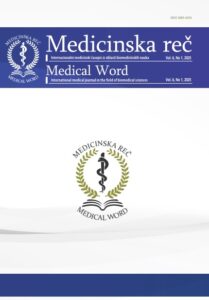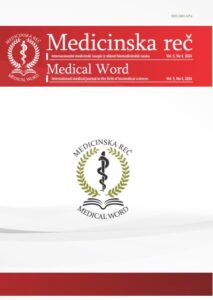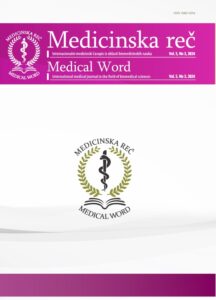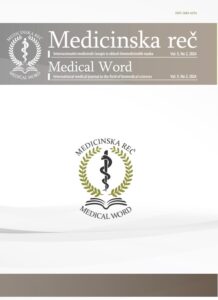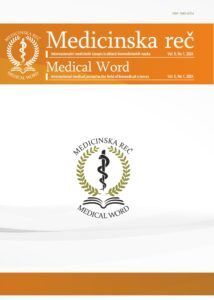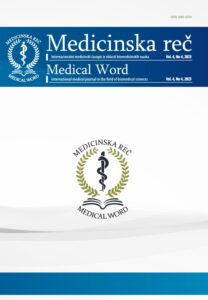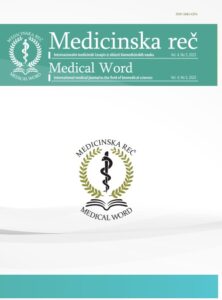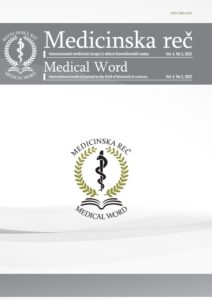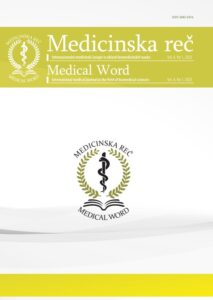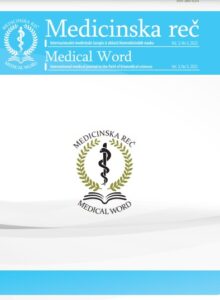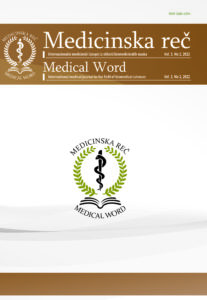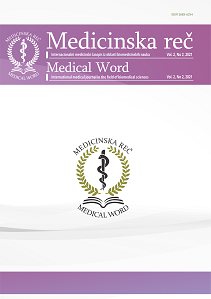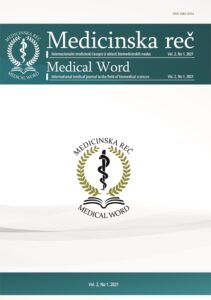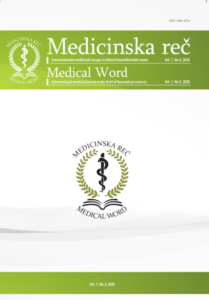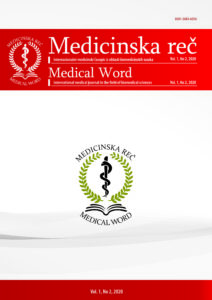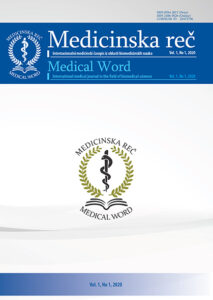Habits and Implementation of Preventive Practices among Women Health Workers
Original article
Ana Adamović, Mile Despotović, Ljiljana Antić, Ana Aničić, Svetlana Čapaković, Milena Zlatanović
99–104
https://doi.org/10.5937/medrec2304099A
Abstract
The health of health workers is viewed from the aspect of the health of the general population, and not as a special group at risk for contracting specific diseases associated with workplace risk factors. The leading diseases in the general population are chronic non-communicable diseases (hypertension, diabetes mellitus, obesity, diseases of the locomotor system…) and they affect the quality of life and professional engagement of this population.
The aim of the research is to examine the health-related habits of female health workers and the presence of chronic diseases in the observed population.
The cross-sectional study included 68 respondents from the population of female health workers, employed in the Ćuprija Health Center. The obtained data were processed in the SPSS 24 program for data processing, using the methods of descriptive and analytical statistics. The Chi square test was used to determine statistical differences, and the usual value of p < 0.05 was taken as the level of statistical significance of differences.
Chronic diseases are present in 52.9% of respondents; of all respondents who have a chronic disease, almost half (48.52%) report hypertension. Of the recommended preventive examinations, once a year, they most often undergo a Pap test (63.20%), breast ultrasound (52%) and clinical breast examination (48%). The average rating of satisfaction with one’s own health on a scale from 0 to 10 is 6.93. The most common reasons for insufficient commitment to health are lack of motivation (41%) and lack of time (34%). For the ratio of the average health rating in relation to the behavior of the respondents, a statistically significant difference was found only in relation to age (χ2 = 15.673; p= 0.044).
This research shows that a significant percentage of female health workers do not pay enough attention to their own health. Female healthcare workers over 45 years of age evaluate their own health with significantly lower scores compared to women under 45 years of age.
Key words: health of women health workers, habits, screening, preventive examinations
Literatura
- World health organization, cardiovascular-diseases. Preuzeto 29.08.2023 sa https://www.who.int/news-room/fact-sheets/detail/cardiovascular-diseases-(cvds)
- World health organization, hypertension. Preuzeto 29.08.2023 sa https://www.who.int/news-room/fact-sheets/detail/hypertension
- Jevremović O, Radević S, Kocić S, Radovanović S, Radovanović J, Selaković V, et al. Epidemiološke karakteristike dijabetes melitusa u srpskim sredinama na Kosovu i Metohiji. Glasnik javnog zdravlja. 2022; 96(2): 165-77.
- Šipetić Grujičić S, Miljuš D, Pavlović N. Nacionalni skrining malignih bolesti u Republici Srbiji. Medicinski podmladak 2014; 65(1-2): 15-21.
- Prevencija malignih bolesti, Nacionalni vodič za lekare u primarnoj zdravstvenoj zaštiti, Republička stručna komisija za izradu i implementaciju vodiča u kliničkoj praksi, Ministarstvo zdravlja Republike Srbije, Srpsko lekarsko društvo, Beograd. 2005.
- Nacionalni vodič dobre kliničke prakse za dijagnostikovanje i lečenje raka dojke, Republička stručna komisija za izradu i implementaciju vodiča dobre kliničke prakse, Ministarstvo zdravlja Republike Srbije, 2012. Available from https://www zdravlje.gov.rs/view_file.php? file_id= 647&cache=sr
- Nacionalni vodič dobre kliničke prakse za dijagnostikovanje i lečenje raka grlića materice, Republička stručna komisija za izradu i implementaciju vodiča dobre kliničke prakse, Ministarstvo zdravlja Republike Srbije 2012. Available from https://www.zdravlje.gov.rs/view_file.php?file_id=649&cache=sr
- Stanulewicz N, Knox E, Narayanasamy M, Shivji N, Khunti K, Blake H. Effectiveness of Lifestyle Health Promotion Interventions for Nurses: A Systematic Review. Int J Environ Res Public Health 2019; 17(1): 17.
- Terada T, Mistura M, Tulloch H, Pipe A, Reed J. Dietary Behaviour Is Associated with Cardiometabolic and Psychological Risk Indicators in Female Hospital Nurses-A Post-Hoc, Cross-Sectional Study. Nutrients 2019; 11(9): 2054.
- Nilan K, McKeever TM, McNeill A, Raw M, Murray RL. Prevalence of tobacco use in healthcare workers: A systematic review and meta-analysis. PLoS One 2019; 14(7): e0220168.
- Priano SM, Hong OS, Chen JL. Lifestyles and Health-Related Outcomes of U.S. Hospital Nurses: A Systematic Review. Nurs Outlook 2018; 66(1): 66-76.
- Mo PK, Blake H, Batt ME. Getting healthcare staff more active: the mediating role of self-efficacy. Br J Health Psychol 2011; 16(4): 690-706.
- Milić N. i sar. Istraživanje zdravlja stanovništva Srbije 2019 godine, Beograd 2021. Available from https://publikacije.stat.gov.rs/G2021/pdf/G20216003.pdf
- Al-Tannir MA, Kobrosly SY, Elbakri NK, Abu-Shaheen AK. Prevalence and predictors of physical exercise among nurses. A cross-sectional study. Saudi Med J 2017; 38(2): 209-12.
- Nicholls R, Perry L, Duffield C, Gallagher R, Pierce H. Barriers and facilitators to healthy eating for nurses in the workplace: an integrative review. J Adv Nurs 2017; 73(5): 1051-65.
- Safiye T, Gutić M, Dubljanin J, Stojanović TM, Dubljanin D, Kovačević A, Zlatanović M, Demirović DH, Nenezić N, Milidrag A. Mentalizing, Resilience, and Mental Health Status among Healthcare Workers during the COVID-19 Pandemic: A Cross-Sectional Study. Int J Environ Res Public Health 2023; 20(8): 5594.


